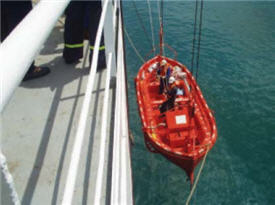Course of events
During re-hooking of the lifeboat after the launching test in connection with the Safety Equipment Certificate survey, extensive movements of the lifting blocks and falls were encountered due to heavy swell and current. Hoisting of the lifeboat was commenced by the mechanically operated davit winch. A strange "jumping" and "unbalance" between the forward and aft wire falls were soon noticed. The hoisting operation was stopped when the lifeboat was about halfway up and it was noticed that the aft wire had escaped from the upper sheave and was jammed between the sheave and he block body. The lifeboat was then secured with extra wires and chain blocks and the crew was taken safely on board the ship again by rope ladder and safety belts. The aft wire was released. The wire, sheave and block were thoroughly examined and refitted. The boat was safely raised to the stowed position.
Extent of damage
No damage to personnel or equipment. However, this event could easily have had serious consequences if not properly addressed in time.
Probable cause
It was likely that the sea condition, with heavy swell and current, caused the aft wire fall to escape from the upper sheave due to the extensive movement of the lifting blocks and falls during the rehooking operation. This situation was discovered only after hoisting the lifeboat about halfway up to its secured position.
Lessons to be learned
- Accidents are, unfortunately, frequently reported in connection with lifeboat tests and drills. Proper maintenance, operation, familiarisation and training are effective means to avoid accidents during lifeboat testing.
- Before the test starts a thorough examination of the lifeboat, davits, wires, sheaves, block etc. is strongly recommended.
- Before starting a lifeboat test, the sea conditions are to be considered for safe launching and recovery.
- During recovery of the lifeboat the following should be considered:
- Lift the lifeboat about one meter above the water level and stop the winch.
- Confirm by visual inspection or communication with lifeboat crew that hooks, securing pins, sheaves blocks, wires etc. are in correct position before recovery is completed. - Whenever any strange behaviour to equipment or in test performance is noticed, the test should be stopped immediately and a thorough check of vital parts should be carried. The test should not commence until the problem is detected and solved.
- In case of any doubt, the test is to be stopped, the crew should be disembarked from the lifeboat, and the recovery of the lifeboat completed without anybody on board.
Source: Det Norske Veritas

This picture is for illustration purposes only (note: calm sea)